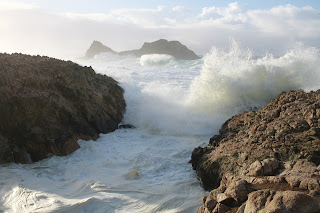Greetings everyone!
All is well out here on the Farallon Islands. We have been spending a lot of our time dodging rain drops and trying not to get blown off this rock. As mentioned in the previous blog we've been experiencing large swells out here and they have continued to impress. We'd like to take this opportunity to introduce this year's team.
 |
| Rainbow coming out of Indian Head Rock on West End Island. December 2015 |
The longer Ryan performs this work the more questions arise about the marine environment. Just when he thinks he has started to figure out certain aspects of this ecosystem he is humbled by the way it continues to throw him for a loop. This is the value of long term datasets and even after 6 years of studying marine mammals on the Farallones there is still so much to learn. Ryan is excited to begin working with this year’s crew and can’t wait for the surprises that will unfold this season. This year has the potential to be the biggest El Nino event since the 1997-98 season and after experiencing prolonged drought on the Farallones new challenges should arise over the next few months.
 |
| Ryan on the island helping with FWS facilities operations. |
Taylor Nairn
– Winter Farallon Research Assistant 2016:
Taylor earned her degree in Environmental Science with a
concentration in Natural Resource Management and Conservation. She currently
works for the Beach Watch program at the Greater Farallones Association, a 22
year ecosystem monitoring program that collects baseline data on beaches in the
Greater Farallones National Marine Sanctuary. She is also highly trained in oil
spill response. When not documenting wildlife and checking data, she enjoys
surfing, road trips, and live music. Taylor is incredibly excited about her
time on SEFI; she looks forward to gaining more intimate knowledge of our
California Current system and wildlife, and looking forward to more adventures
in island biogeography that this opportunity could bring.
 |
| Taylor on the National Marine Sanctuaries R/V Fulmar during an ACCESS cruise. |
 |
| Cassie conducting field research along the California coast. |
Ross Nichols
– Winter Farallon Research Assistant 2016:
 |
| Ross doing some scope work at the Lighthouse. |
Scarlett
Hutchin – Winter Farallon Research Assistant 2016:
Scarlett Hutchin completed a Postgraduate Certificate at
Oxford University this year, where she studied Manx shearwater foraging
behaviour in the Irish Sea using GPS tracking. After completing
internships and volunteer placements on various islands in the UK and one in
the Seychelles, Scarlett a spent summer on SEFI in 2013 and has been looking
for a way to come back to this extraordinary place ever since. She
originally trained in metalwork conservation and is leaving behind a career as
a sculpture conservator in London in order to embark on new adventures.
When she’s not working with seabirds and marine mammals or cleaning
historic bronzes, Scarlett mostly likes to eat and climb.
 |
| Scarlett collecting tag resight data on the resident elephant seals. |
Speaking of eating, we had a quiet Christmas out here in the middle of the Pacific. We did a proper feast that consisted of a 20 lb turkey, mashed potatoes, yams, stuffing in a pumpkin, steamed carrots, salad, garlic bread, marzipan, apple pie and mulled cider.
 |
| Farallon Winter 2015-16 Christmas dinner. |
In closing this blog the elephant seal breeding season is starting to ramp up. We now have 10 cows in our breeding colonies and the first pup of the season was born on December 26th. This cow arrived to the island on December 22nd. In comparison to last year the first cow arrived on December 18th and pupped on the 22nd. This year's first pup was born 4 days later compared to last year. More exciting news to come! Check back soon!











